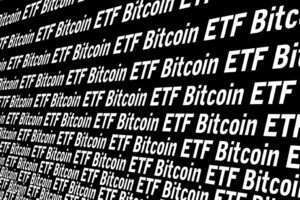Despite Bitcoin surpassing a market cap of 1 trillion dollars with hundreds of millions active users, it still faces criticism. Detractors label it a tool for criminals or a speculative gamble with no real future in the global financial system. To date, that narrative is still there. Though, Bitcoin’s early critics were not entirely unjustified. The last 15 years have seen Bitcoin transition from a grassroots movement to rapid adoption within big financial institutions. But how is Bitcoin shaping the future of finance?
Larry Fink, CEO of BlackRock, recently changed tune. Once a sceptic, Fink believes Bitcoin is on a path to becoming a standalone asset class, comparable to other financial innovations that began slowly and later scaled. The mortgage and high-yield bond markets are good examples. He dismisses the notion that Bitcoin’s trajectory depends on political outcomes, stating that neither US president-elect will significantly alter its growth.
This bullish stance is underscored by the success of BlackRock’s spot bitcoin ETF, which launched in January 2024 and has already amassed over $23 billion in assets. The record-breaking inflows into bitcoin ETFs signal a growing institutional appetite, outpacing even gold-based products in terms of capital inflows. In just ten months, bitcoin ETFs have attracted nearly $20 billion, compared to gold ETFs, which have only drawn $1.4 billion despite reaching record highs 30 times this year.
MicroStrategy’s Infinite Money Glitch
This transition became evident when companies in the stock market started holding Bitcoins on their books as part of their reserve. MicroStrategy, in particular, has emerged as a pioneer in this direction, showing how Bitcoin can also be a strategic asset in the rather unique epoch – creating an entirely new category of base money.
In late 2020, MicroStrategy’s CEO, Michael Saylor, made headlines when the company announced it had purchased Bitcoin with its cash reserves. Saylor argued that fiat currencies are depreciating over the long term, highlighting the need for a stable alternative.
This was not a gamble on Bitcoin’s price appreciation in the future but precise leverage on unique attributes of Bitcoin as a currency and store of value. MicroStrategy’s Bitcoin initiative, now known as the “MicroStrategy playbook,” has inspired other companies like Metaplanet to follow suit. This trend highlights why Bitcoin is poised to disrupt corporate finance.
Bitcoin as a Strategic Reserve: MicroStrategy’s Financial Innovation
Investing in Bitcoin is at the heart of MicroStrategy’s plan, and it uses convertible debt to buy Bitcoin regularly. MicroStrategy sold convertible notes with very low interest rates and used the proceeds to purchase Bitcoin. This strategy allows the company to take advantage of “global carry” by borrowing at low rates and investing in an asset with long-term growth potential.
At the same time, holding Bitcoin places the company in a short position on global carry because Bitcoin is inherently deflationary. Its supply remains fixed and predictable as global liquidity grows, leaving only its price to adjust in response to increasing demand.
This position – being long and short on global carry simultaneously – is unique. MicroStrategy effectively becomes a modern version of a 60/40 portfolio, with the unique twist that both the long and short positions exist within a single asset. Saylor has structured a scenario where MicroStrategy benefits from global liquidity and Bitcoin’s scarcity. This approach has been described by some as an “infinite money glitch.”
The Fading Wisdom of 60/40
The old 60/40 portfolio comprises 60% stocks and 40% bonds and has been the benchmark portfolio for moderately risky investments. The theory behind it was simple: equities provided a growth factor. Bonds, on the other hand, offered stability and an income factor in this risky venture.
However, this traditional model loses effectiveness in an environment of low interest rates. Excessive growth in the money supply further reduces its impact. Currencies are now speculative, and the ups and downs of the stock depend on regulations and a select few monopolistic companies.
The outsized performance of a select few companies – the “Magnificent Seven” – has skewed overall market returns, masking weaker performances elsewhere. By mid-2024, this group, which includes giants like Apple, Microsoft, and Tesla, delivered an average return of 57% over the previous year. This performance was more than double the 25% return of the broader S&P 500.
Despite the unattractive chart, seven mega-cap stocks now make up 31% of the S&P’s weight. These stocks have significantly outperformed, boosting the performance of Simply Good Funds’ S&P 500 index trackers for several years. Yet, most investors appear inclined to overlook these seven stocks. Indeed, if they were omitted in the computation, the S&P 500 index at 18.1% in July 2024 would decrease to 9%. This disparity illustrates how concentrated market performance has become.
Bitcoin: A New Strategic Asset for Modern Treasury Management
The decision by companies like MicroStrategy to adopt Bitcoin represents an important shift in how businesses view treasury management in the economy. Hedging balance sheets have been accomplished through cash balance, bonds, and other fiat instruments for many years. However, due to constant interference by central banks and other regulators, traditional assets degenerate into value vacuums.
At the time of this write-up, Bitcoin’s market capitalization stands around $1.4 trillion. This is approximately one-tenth of gold’s $13 trillion market value.
With increased usage, the ability to trade Bitcoin and the mechanisms for doing so continue to evolve. This evolution makes it easier for large institutions to execute substantial trades without impacting the overall market. At the time of this write-up, Bitcoin’s market capitalization stands around $1.4 trillion. This is approximately one-tenth of gold’s $13 trillion market value. They are beginning to see that it can achieve much more than early adopters initially anticipated.
Bitcoin’s $100 Trillion Potential
At the time of this write-up, Bitcoin’s market capitalization stands around $1.4 trillion. This is approximately one-tenth of gold’s $13 trillion market value. Undoubtedly, Bitcoin has proven itself as one of the best-performing assets over the past decade. With the trend observed in 2024, particularly in recent weeks, Bitcoin adoption is set to increase. Institutions, governments, and even corporations are likely to adopt it further. If this scenario unfolds, Bitcoin could realistically rival or even surpass gold’s market cap. It has the potential to reach the status of a $100 trillion asset class.
MicroStrategy’s bold moves are just but a glimpse of a massive shift in corporate finance. If more companies recognize this unique moment and what it is, they, too, could take advantage of MicroStrategy’s infinite money glitch. The next wave of BTC adoption will be in the corporate balance sheets. Indeed, it is a new chapter for digital finance.
Image Source: Adobe Stock
Disclaimer: This article is provided for informational purposes only. It is not offered or intended to be used for legal, tax, investment or financial advice.












